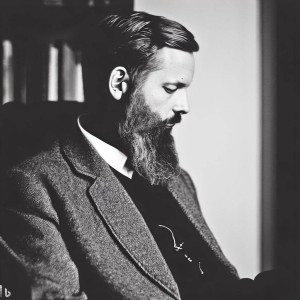Nightly Narratives: Delving into Freud’s Theory of Dream Interpretation

Dive into the intriguing realm of dream interpretation as developed by Sigmund Freud. Delving beyond the mere fantasy, we explore Freud’s view on the unconscious mind’s narrative woven into our nocturnal reveries.”
I. Introduction
A. The Mysterious Landscape of the Unconscious: Decoding Dreams with Freud
The human mind, a vast and intricate landscape filled with complex emotions, thoughts, and memories, has been the subject of fascination for centuries. Yet, one aspect that particularly intrigues psychologists, philosophers, and dreamers alike, is the elusive and often baffling world of dreams. These nightly narratives, seemingly a blend of fantasy, memory, and occasionally, uncanny prophecy, were examined closely by one man in particular: Sigmund Freud. Diving into the intriguing domain of dream interpretation, Freud’s work invites us to explore our nocturnal reveries and understand our unconscious desires more intimately.
II. Origins of Freud’s Dream Interpretation
A. Freud’s Personal Background
Born to a wool merchant and his third wife in 1856 in what is now the Czech Republic, Sigmund Freud spent most of his life in Vienna. His early fascination with science and desire to understand the workings of the human mind led him to the University of Vienna’s Medical School. Initially focusing on neurology, he developed a keen interest in hypnosis as a form of therapy, studying under esteemed clinicians such as Jean-Martin Charcot and Josef Breuer. Freud’s immersion in hypnosis and the exploration of the human mind set the stage for his later work on psychoanalysis and dream interpretation.
B. Emergence of Psychoanalysis
Freud’s development of psychoanalysis marked a turning point in psychology. He rejected the prevailing notion that mental disorders resulted solely from physiological processes. Instead, Freud proposed that psychological factors played a significant role. This revolutionary idea, coupled with his view that our conscious mind represents only a fraction of our total psyche, led to the birth of psychoanalysis. It was a framework designed to unlock the mysteries of the unconscious, where he believed unresolved conflicts and repressed desires reside. The interpretation of dreams was central to psychoanalysis, which Freud saw as a royal road to the unconscious.
C. The Unconscious Mind Theory
To Freud, the mind was akin to an iceberg, with a vast portion hidden beneath the surface of conscious awareness. This hidden section, the unconscious, was, he believed, a repository of repressed desires, traumatic memories, and primal instincts. Through various techniques, such as free association and dream analysis, Freud sought to bring these unconscious contents into conscious awareness, thereby helping individuals resolve their inner conflicts. In this context, Freud’s fascination with dreams and their interpretations took root, leading to his influential and contentious work, “The Interpretation of Dreams,” forever altering our understanding of why and how we dream.
III. Key Concepts of Freudian Dream Analysis
A. Manifest and Latent Content
Freud introduced the concepts of manifest and latent content to explain the nature of dreams. Manifest content refers to the literal storyline of the dream – the sequence of events as we remember them upon awakening. This, Freud proposed, was merely the tip of the iceberg. Beneath the manifest content lies the latent content, or the hidden psychological meaning of the dream. These disguised thoughts, shielded by the process Freud named ‘dream-work’, often reflected repressed desires and unresolved conflicts from the individual’s past.
B. Role of Wish Fulfillment
At the heart of Freud’s dream analysis is wish fulfillment. Freud posited that every dream represents a wish fulfillment, a disguised fulfillment of repressed or inhibited desires, particularly those originating from childhood. Often unacceptable to the conscious mind, the dream-work process transforms these wishes into a more palatable form. Thus, dreams become a ‘safety valve’ for the unconscious mind, a space where these repressed desires can find expression without causing distress to the waking mind.
C. Freud’s Dream Symbols
Freudian dream analysis also leans heavily on the interpretation of dream symbols. According to Freud, our dreams are full of symbols representing our repressed desires and anxieties. Each symbol, from ordinary objects to complex scenarios, holds significant meaning relating to the dreamer’s personal experiences and unconscious thoughts. Freud’s symbol interpretations often linked to sexual and aggressive desires, reflecting his belief in these as fundamental human drives.
IV. Case Studies in Freudian Nighttime Reverie Interpretation
A. Rat Man and Wolf Man
Freud’s interpretations of his patients’ dreams, famously known as the Rat Man and the Wolf Man served as potent demonstrations of his dream theory. The Rat Man, troubled by a dream of rats, was interpreted by Freud as fearing debt and guilt over sexual desires. The Wolf Man, who dreamt of white wolves sitting in a tree, was interpreted as having childhood fears and repressed memories. These cases, detailed in Freud’s writings, provided fascinating insights into the workings of the unconscious mind.
B. Freud’s Own Dreams
Freud was not just an analyst of others’ dreams but also used his dreams for analysis and theory-building. His dream of ‘Irma’s injection,’ for example, reflected his guilt over a patient’s lack of improvement and became a foundation for his theory of wish fulfillment. Freud’s use of his dreams demonstrated his belief in the universality of his dream theory and offered a subjective insight into his method.
C. Contemporary Application
Despite modern psychology’s movement away from Freudian theories, elements of his dream interpretation methods continue to find relevance in contemporary psychotherapy. Some therapists utilize aspects of dream analysis to explore the unconscious dynamics of their clients, often in combination with other therapeutic techniques. While the specific symbols and their interpretations, as proposed by Freud, are less often used, the general idea of dreams as meaningful expressions of unconscious desires still hold significance in certain therapy contexts.
V. Criticisms and Limitations of Freud’s Nocturnal Vision Analysis
A. Scientific Examination
While revolutionary, Freud’s theory of dream interpretation has been subjected to considerable criticism. One of the key criticisms lies in the need for more empirical support for his claims. Freud’s theories are based on his observations and case studies, which, though compelling, fail to meet the modern standards of scientific rigor. The subjective nature of his theory, particularly the reliance on symbolic interpretations, has been critiqued as being non-falsifiable, rendering it scientifically problematic.
B. Comparisons with Other Theories
Unlike other theories of dreams, such as the cognitive and neurobiological theories, Freud’s approach might seem overly centered on sexual and aggressive drives. The cognitive perspective, for instance, views dreams as a reflection of cognitive processes like memory consolidation or problem-solving, a view supported by much empirical research. Similarly, the neurobiological approach suggests dreams are a byproduct of the brain’s nightly ‘housekeeping’ duties. These theories, grounded in experimental evidence, contrast Freud’s psychoanalytic interpretation of dreams.
C. Evolution in Modern Psychology
While recognizing Freud’s significant contributions, modern psychology has largely moved beyond his specific theories. The development of cognitive-behavioral therapy and the advancement of neuroscience have introduced new perspectives on dreams. These areas consider a wider range of factors influencing dreams, such as daily experiences, cognitive processes, and brain activity during sleep. Therefore, while Freud’s theories remain historically important, they are sometimes central to contemporary dream research or therapeutic practice.
VI. Enduring Influence of Freud’s Slumber Thought Analysis
A. Influence on Psychotherapy
Despite the criticisms and limitations, Freud’s dream analysis holds value in some psychotherapy areas. While few therapists today would identify as strictly Freudian, many incorporate elements of dream analysis into their practice. By providing a framework to explore the unconscious mind, Freud’s theories allow therapists to delve deeper into their clients’ psyches, helping to unravel hidden conflicts and repressed emotions.
B. Cultural Impact
Freud’s theories have influenced Western culture, art, literature, and film. References to Freudian concepts, such as the Oedipus complex or the interpretation of dreams, are common in cultural discourse. His work has also helped demystify dreams, encouraging individuals to explore their dreams as a pathway to personal understanding and growth.
C. The Future of Freud’s Dream Theory
Despite being over a century old, Freud’s theories on dream interpretation continue to generate interest and debate. Future research and advancements in psychology and neuroscience might yield new perspectives on Freud’s theories, allowing for reinterpretations and refinements. As long as dreams fascinate and puzzle us, Freud’s dream theory will likely maintain its enduring relevance.
FAQs
Q: What is Freud’s theory of dream interpretation?
A: Freud believed dreams were a form of wish fulfillment, where repressed desires and unresolved conflicts from the unconscious are expressed in a disguised form. He differentiated between manifest content, the literal storyline of the dream, and latent content, the underlying symbolic meaning.
Q: What is the difference between manifest and latent content in Freud’s dream theory?
A: Manifest content refers to the actual events or storyline of the dream as remembered by the dreamer. In contrast, latent content is the hidden psychological meaning behind these events, often tied to repressed desires and unresolved conflicts.
Q: What is the role of wish fulfillment in Freud’s theory of dreams?
A: Freud proposed that dreams were a form of ‘wish fulfillment’, representing the disguised fulfillment of repressed desires, particularly those originating from childhood. These desires, unacceptable to the conscious mind, are transformed into a more acceptable form through the dream-work process.
Q: How did Freud interpret dream symbols?
A: Freud viewed dream symbols as representations of repressed desires and anxieties. Each symbol, whether an object, a person, or a scenario, held significant meaning relating to the dreamer’s experiences and unconscious thoughts.
Q: What are some criticisms of Freud’s dream interpretation theory?
A: Freud’s theory has been critiqued for its lack of empirical evidence and subjective, non-falsifiable nature. It’s also been criticized for overemphasizing sexual and aggressive drives. Modern theories grounded in cognitive processes and neurobiology contrast Freud’s interpretations.
Q: How does Freud’s theory of dream interpretation influence modern psychology?
A: Despite criticisms, Freud’s theories continue to influence certain areas of psychotherapy, particularly those that explore the unconscious mind. However, modern psychology has evolved to consider other factors influencing dreams, such as cognitive processes and neurological activities.
Q: What is the cultural impact of Freud’s dream theory?
A: Freud’s dream theory has had a significant influence on Western culture, inspiring art, literature, and film. His work has demystified dreams and encouraged personal exploration of dreams to understand the self.
Conclusion
A. Modern Understanding
Despite criticism and evolving theories in psychology, Freud’s dream interpretation theory remains a touchstone in our understanding of dreams. While the exact interpretations of symbols and scenarios have been questioned, the idea that our dreams might hold hidden meaning tied to our unconscious desires continues to intrigue researchers and laypersons alike.
B. Continuing Debate
The scientific and philosophical debate around Freud’s theory keeps his work alive in academic and cultural discourse. As our understanding of the human mind and brain develops, so will our perspectives on dreams and their interpretation. Freud’s dream theory, controversial as it may be, provides a robust starting point for these explorations.
C. Personal Exploration
On a personal level, Freud’s dream interpretation theory invites us to explore the deeper layers of our psyche. While we may not all subscribe to Freud’s specific interpretations, probing our dreams for insights into our desires, fears, and conflicts can enrich self-understanding. In this sense, the relevance of Freud’s theory extends beyond the academic realm, offering tools for personal introspection and self-discovery.
Suggested Readings
For those curious to delve deeper into Freud’s fascinating exploration of the world of dreams, the following books offer a comprehensive look into his theories, case studies, and their enduring impact. Each book presents a unique perspective, allowing readers to build a nuanced understanding of Freud’s approach to dream interpretation.
- “The Interpretation of Dreams” by Sigmund Freud: This is Freud’s seminal work where he first introduced his theory of dream interpretation. A must-read for anyone interested in Freudian psychology, it offers a first-hand view of his thoughts on dreams as wish fulfillment and his concept of the unconscious mind.
- “Freud’s Discovery of Psychoanalysis: The Politics of Hysteria” by William J. McGrath provides a detailed look into the origins of Freud’s theories, including his work on dream analysis, offering an insightful backdrop against which to understand his thought process.
- “Delusion and Dream in Wilhelm Jensen’s Gradiva” by Sigmund Freud: In this work, Freud demonstrates his technique of dream interpretation by analyzing the dreams in a novel, providing a fascinating application of his theories.
- “Freud and Beyond: A History of Modern Psychoanalytic Thought” by Stephen A. Mitchell and Margaret J. Black: This book offers a broader view of psychoanalytic thought, covering Freud’s contributions and how his theories, including his dream interpretation, have been developed and critiqued over time.
- “Dream Psychology: Psychoanalysis for Beginners” by Sigmund Freud is an accessible introduction to Freud’s dream interpretation and his larger body of psychoanalytic work, making it a great starting point for beginners.
Whether you’re a scholar, student, or simply someone intrigued by the mysterious world of dreams, these texts offer a rich exploration of Freud’s revolutionary ideas. Through these readings, you may gain a deeper understanding of dream interpretation from the Freudian perspective and an appreciation for its enduring influence on psychology and culture.






